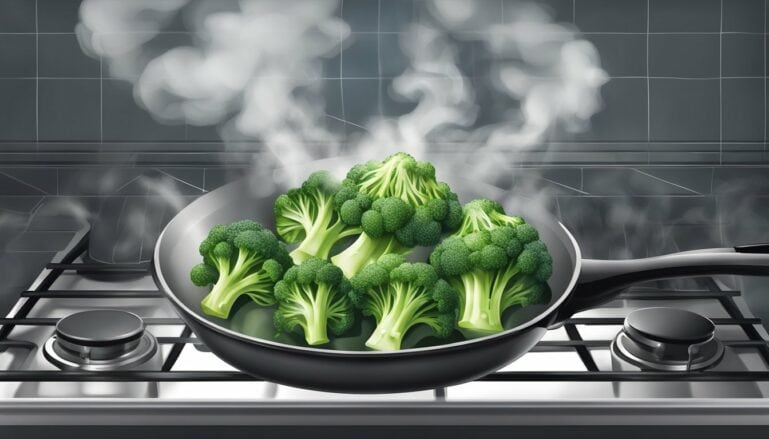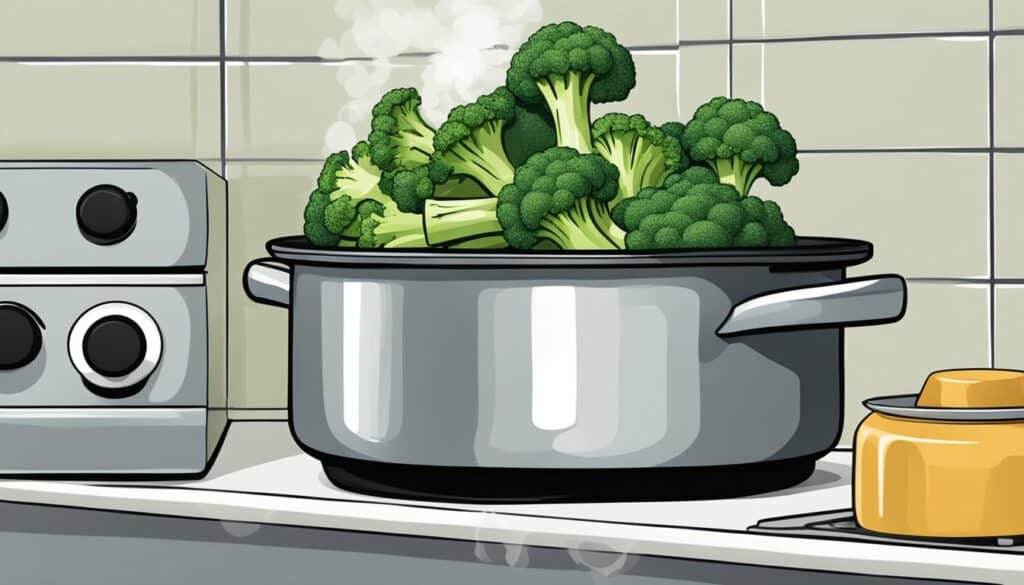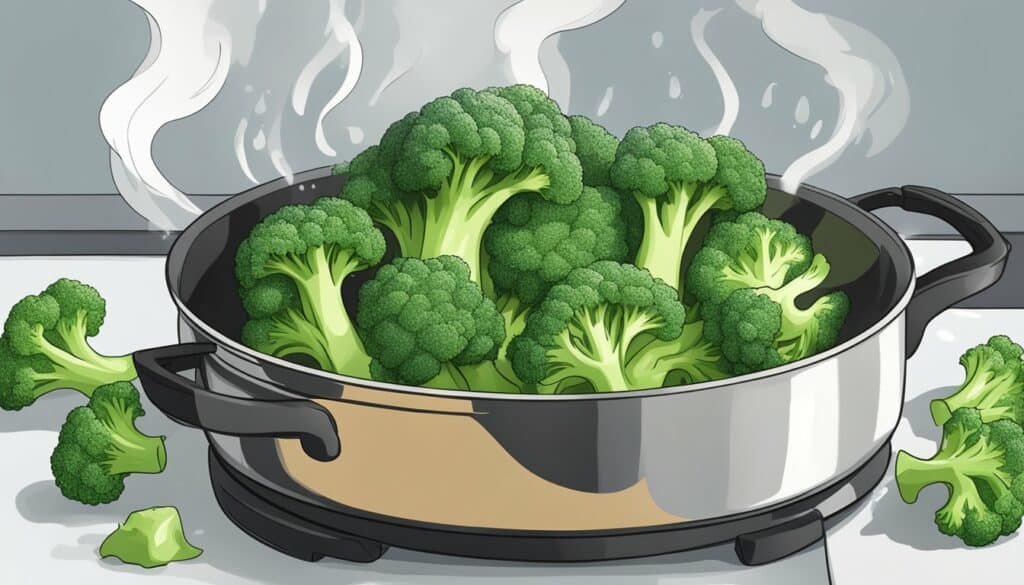How to Cook Frozen Broccoli: Quick and Easy Tips

Table of Contents
Understanding Frozen Broccoli
Frozen broccoli is a convenient and nutritious option for those who want to add more vegetables to their diet. As the name suggests, frozen broccoli is broccoli that has been frozen shortly after being harvested. This process helps to preserve the nutrients and flavor of the vegetable.
One of the benefits of frozen broccoli is that it is available year-round and can be easily stored in the freezer. Frozen broccoli is also a great option for those who don’t have access to fresh broccoli or who want to save time on meal prep.
When it comes to nutrition, frozen broccoli is just as nutritious as fresh broccoli. In fact, frozen broccoli may be even more nutritious since it is picked and frozen at the peak of ripeness. Frozen broccoli is a good source of vitamins and minerals such as vitamin C, vitamin K, folate, and potassium.
When cooking frozen broccoli, it is important to note that it is already blanched, which means that it has been partially cooked. Therefore, it doesn’t need to be cooked for as long as fresh broccoli. Overcooking frozen broccoli can lead to a mushy texture and loss of nutrients.
In summary, frozen broccoli is a nutritious and convenient option for those who want to add more vegetables to their diet. It is just as nutritious as fresh broccoli and can be easily stored in the freezer. When cooking frozen broccoli, it is important to be mindful of its blanched state and avoid overcooking.
Choosing Cooking Methods
When it comes to cooking frozen broccoli, there are several methods you can use to achieve the desired taste and texture. Here are some of the most popular methods to cook frozen broccoli:
Roasting Frozen Broccoli
Roasting frozen broccoli is a great way to add some crunch and char to your broccoli. To roast frozen broccoli, preheat your oven to 425°F and spread the broccoli on a baking sheet. Drizzle with olive oil, season with salt and pepper, and roast for 20-25 minutes, or until the broccoli is crispy and tender.
Microwaving Frozen Broccoli
Microwaving frozen broccoli is a quick and easy way to cook it. Simply place the broccoli in a microwave-safe dish, add a splash of water, cover with a lid or plastic wrap, and microwave for 4-5 minutes, or until the broccoli is tender.
Steaming Frozen Broccoli
Steaming frozen broccoli is a healthy way to cook it, as it preserves most of the nutrients. To steam frozen broccoli, place it in a steamer basket over a pot of boiling water. Cover with a lid and steam for 5-7 minutes, or until the broccoli is tender.
Boiling Frozen Broccoli
Boiling frozen broccoli is another quick and easy way to cook it. To boil frozen broccoli, bring a pot of salted water to a boil, add the broccoli, and cook for 3-5 minutes, or until the broccoli is tender.
Sautéing Frozen Broccoli
Sautéing frozen broccoli is a great way to add some flavor to it. To sauté frozen broccoli, heat some olive oil in a pan over medium-high heat. Add the broccoli and sauté for 5-7 minutes, or until the broccoli is crispy and tender.
Stir-Frying Frozen Broccoli
Stir-frying frozen broccoli is a quick and easy way to cook it, and it’s perfect for adding to stir-fries or noodle dishes. To stir-fry frozen broccoli, heat some oil in a wok or pan over high heat. Add the broccoli and stir-fry for 3-5 minutes, or until the broccoli is tender.
Remember to choose a cooking method that suits your taste and needs. Whether you prefer crispy or tender broccoli, there is a cooking method that will work for you.

Preparation Steps
To cook frozen broccoli, there are a few preparation steps that you should follow. Here are the steps that I recommend:
- Preheat your oven to 400°F (204°C).
- Line a baking sheet with parchment paper.
- Spread the frozen broccoli florets in a single layer on the baking sheet.
- Drizzle some olive oil over the broccoli.
- Season with salt and pepper to taste.
- Add some minced garlic if desired.
- Squeeze some fresh lemon juice over the broccoli.
- Bake for 15-20 minutes, or until the broccoli is tender and slightly browned.
Alternatively, you can also cook frozen broccoli in the microwave or on the stovetop. Here’s how:
Microwave Method:
- Place the frozen broccoli in a microwave-safe dish.
- Add a tablespoon of water to the dish.
- Cover the dish with a lid or plastic wrap.
- Microwave on high for 3-4 minutes, or until the broccoli is tender.
- Drain any excess water and serve.
Stovetop Method:
- Bring a pot of salted water to a boil.
- Add the frozen broccoli florets to a steamer basket.
- Place the steamer basket over the boiling water.
- Cover the pot with a lid and steam for 5-7 minutes, or until the broccoli is tender.
- Remove the steamer basket from the pot and drain any excess water using a colander or sieve.
- Season the broccoli with salt, pepper, and olive oil, if desired.
Overall, cooking frozen broccoli is a quick and easy way to add some veggies to your meal. By following these simple preparation steps, you can enjoy delicious and nutritious broccoli in no time!
Seasoning and Flavoring
When it comes to seasoning frozen broccoli, there are a few things to keep in mind. First and foremost, you want to enhance the natural flavor of the broccoli without overpowering it. Here are some seasoning and flavoring options that I recommend:
- Garlic powder: A sprinkle of garlic powder can add a savory kick to your broccoli. Be careful not to use too much, as it can easily overpower the dish.
- Lemon juice and zest: A squeeze of fresh lemon juice and a pinch of lemon zest can brighten up the flavor of your broccoli and give it a refreshing zing.
- Parmesan cheese: Grated Parmesan cheese can add a nutty, salty flavor to your broccoli. Sprinkle it on top of the broccoli or mix it in with the seasoning.
- Cheese sauce: If you’re looking for a more indulgent option, try adding a cheese sauce to your broccoli. This can be made from scratch or purchased pre-made.
- Kosher salt and black pepper: These classic seasonings can help bring out the natural flavor of the broccoli. Be sure to season to taste.
- Crushed red pepper: For a spicy kick, add a pinch of crushed red pepper to your broccoli. Be careful not to use too much, as it can quickly become overpowering.
Remember, the key to seasoning frozen broccoli is to enhance its flavor without overpowering it. Use these options as a starting point, and feel free to experiment with other seasonings and flavorings to find what works best for you.
Avoiding Common Mistakes
When cooking frozen broccoli, it’s important to avoid some common mistakes to achieve the best results. Here are some tips to help you cook frozen broccoli perfectly every time:
-
Don’t overcrowd the pan: If you add too much broccoli to the pan, it will steam instead of roast, resulting in a mushy texture. Make sure to spread the broccoli out in a single layer on the baking sheet to ensure it roasts evenly.
-
Don’t overcook the broccoli: Overcooking the broccoli will make it mushy and lose its bright green color. Cook the broccoli until it’s tender but still has a slight crunch.
-
Avoid brown spots: Brown spots on broccoli are a sign of overcooking or uneven cooking. Make sure to spread the broccoli out evenly on the baking sheet and check it frequently to avoid brown spots.
-
Remove excess moisture: Frozen broccoli contains a lot of moisture, which can cause it to steam instead of roast. To remove excess moisture, place the broccoli in a colander and rinse it under cold water. Then, pat it dry with a paper towel before roasting.
-
Use high heat: Roasting frozen broccoli at a high temperature (around 425°F) will help it get crispy and caramelized. Make sure to preheat the oven before roasting to ensure it’s hot enough.
By following these simple tips, you can achieve perfectly roasted frozen broccoli every time.
Storing and Reheating
When it comes to storing frozen broccoli, it’s important to keep it in an airtight container to prevent freezer burn. If you have leftovers, store them in the refrigerator within two hours of cooking.
To reheat frozen broccoli, there are a few options. The easiest way is to microwave it for a few minutes until it’s heated through. Alternatively, you can thaw the broccoli in the refrigerator overnight and then steam it on the stove.
When reheating frozen broccoli, be careful not to overcook it as it can become mushy. I recommend checking it frequently and stirring it occasionally to ensure even heating.
Overall, frozen broccoli can be a convenient and healthy addition to any meal. With proper storage and reheating techniques, you can enjoy it anytime without sacrificing taste or texture.

Incorporating into Recipes
When it comes to incorporating frozen broccoli into recipes, the possibilities are endless. Here are some simple and delicious ideas:
-
Side dish: Steam the broccoli and season it with salt, pepper, and a drizzle of olive oil. Serve it alongside your favorite protein for a healthy and flavorful side dish.
-
Soup: Add frozen broccoli to your favorite soup recipe. It’s an easy way to add extra nutrients and flavor to your soup.
-
Casserole: Combine frozen broccoli with cooked rice, cheese, and your favorite seasonings. Bake it in the oven for a tasty and satisfying casserole.
-
Quiche: Add frozen broccoli to your quiche filling for a nutritious and delicious breakfast or brunch option.
-
Roasting frozen broccoli: Roasting frozen broccoli is a great way to bring out its natural sweetness and add a crispy texture. Simply toss the frozen broccoli with olive oil, salt, and pepper, and roast it in the oven at 400°F for 20-25 minutes.
-
Roasted frozen broccoli: For a more flavorful roasted broccoli, try adding garlic, lemon juice, or parmesan cheese to the mix.
With these ideas, you can easily incorporate frozen broccoli into your meals and enjoy its many health benefits.
Dietary Considerations
When cooking frozen broccoli, it’s important to consider any dietary restrictions or preferences. As a vegan myself, I always make sure to choose recipes that are plant-based and free of animal products. Here are some dietary considerations to keep in mind:
-
Vegan: If you’re vegan, make sure to use vegetable broth or water instead of chicken broth when cooking your broccoli. You can also add some plant-based protein to your dish, such as tofu or chickpeas, to make it more filling.
-
Vegetarian: If you’re vegetarian, you can use either vegetable or chicken broth when cooking your broccoli. You can also add some cheese or eggs to your dish for extra flavor and protein.
-
Gluten-free: If you’re gluten-free, make sure to check the labels of any sauces or seasonings you’re using to make sure they don’t contain wheat or other gluten-containing ingredients. You can also use gluten-free pasta or rice as a base for your broccoli dish.
Overall, cooking frozen broccoli is a great way to add some nutritious veggies to your diet. By keeping these dietary considerations in mind, you can make sure that your dish is both delicious and suitable for your dietary needs.